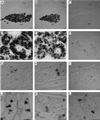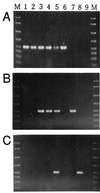Endosymbiotic microbiota of the bamboo pseudococcid Antonina crawii (Insecta, Homoptera)
- PMID: 10653730
- PMCID: PMC91875
- DOI: 10.1128/AEM.66.2.643-650.2000
Endosymbiotic microbiota of the bamboo pseudococcid Antonina crawii (Insecta, Homoptera)
Abstract
We characterized the intracellular symbiotic microbiota of the bamboo pseudococcid Antonina crawii by performing a molecular phylogenetic analysis in combination with in situ hybridization. Almost the entire length of the bacterial 16S rRNA gene was amplified and cloned from A. crawii whole DNA. Restriction fragment length polymorphism analysis revealed that the clones obtained included three distinct types of sequences. Nucleotide sequences of the three types were determined and subjected to a molecular phylogenetic analysis. The first sequence was a member of the gamma subdivision of the division Proteobacteria (gamma-Proteobacteria) to which no sequences in the database were closely related, although the sequences of endosymbionts of other homopterans, such as psyllids and aphids, were distantly related. The second sequence was a beta-Proteobacteria sequence and formed a monophyletic group with the sequences of endosymbionts from other pseudococcids. The third sequence exhibited a high level of similarity to sequences of Spiroplasma spp. from ladybird beetles and a tick. Localization of the endosymbionts was determined by using tissue sections of A. crawii and in situ hybridization with specific oligonucleotide probes. The gamma- and beta-Proteobacteria symbionts were packed in the cytoplasm of the same mycetocytes (or bacteriocytes) and formed a large mycetome (or bacteriome) in the abdomen. The spiroplasma symbionts were also present intracellularly in various tissues at a low density. We observed that the anterior poles of developing eggs in the ovaries were infected by the gamma- and beta-Proteobacteria symbionts in a systematic way, which ensured vertical transmission. Five representative pseudococcids were examined by performing diagnostic PCR experiments with specific primers; the beta-Proteobacteria symbiont was detected in all five pseudococcids, the gamma-Proteobacteria symbiont was found in three, and the spiroplasma symbiont was detected only in A. crawii.
Figures






References
-
- Adachi J, Hasegawa M. MOLPHY version 2.3: programs for molecular phylogenetics based on maximum likelihood. Comput Sci Monogr Inst Stat Math (Tokyo) 1996;28:1–150.
-
- Baumann P, Moran N A. Non-cultivable microorganisms from symbiotic associations of insects and other hosts. Antonie Leeuwenhoek. 1997;72:38–48. - PubMed
-
- Baumann P, Baumann L, Lai C-Y, Rouhbakhsh D, Moran N A, Clark M A. Genetics, physiology and evolutionary relationships of the genus Buchnera: intracellular symbionts of aphids. Annu Rev Microbiol. 1995;49:55–94. - PubMed
Publication types
MeSH terms
Substances
Associated data
- Actions
- Actions
- Actions
LinkOut - more resources
Full Text Sources
Molecular Biology Databases
Miscellaneous

